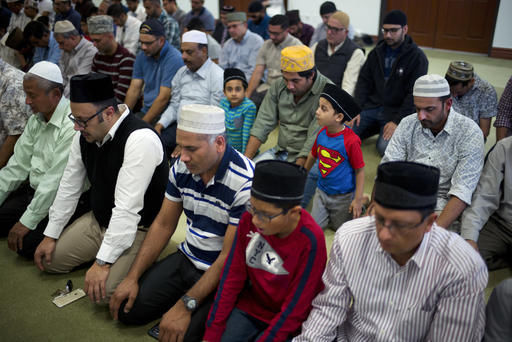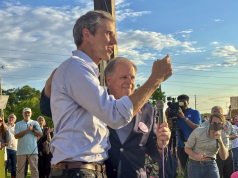
By Christine Armario and Amy Taxin
Associated Press

SAN BERNARDINO, Calif. (AP) – Almost a year after her father was killed in the San Bernardino terror attack last December, Kate Bowman etched the word “love” in yellow chalk on the sidewalk outside a mosque.
It was one of many messages of peace the 15-year-old and her mother have left in an effort to unify Muslims and Christians in the hardscrabble city east of Los Angeles against the violence many community members feared might divide them but hasn’t.
“What angered me most after Dec. 2 was the amount of hate speech going on,” Bowman said, recalling the day her father, Harry Bowman, and 13 others were killed by husband-and-wife assailants at a lunch meeting for county health inspectors in San Bernardino.
“I just kind of didn’t understand how people could be that ignorant about another religion” and blame all those who follow it, said Bowman, a Lutheran.
Bowman’s actions were among the efforts in the city of 216,000 to counter what some feared would be a prolonged, hate-filled backlash. Some victims’ families encouraged dialogue and tolerance. The Muslim community undertook its own campaign to educate neighbors about Islam. Clergy organized interfaith talks.
Nationwide, hate crimes against Muslims were up last year and President-elect Donald Trump frequently used heated rhetoric about Muslims on the campaign trail.
As San Bernardino prepared this week to mark Friday’s anniversary of the attack, a Somali-born Muslim student carried out an attack at Ohio State University and police in Los Angeles met with Muslim leaders to condemn threatening, hateful letters sent to mosques in the city and elsewhere.
In San Bernardino, apart from some relatively minor incidents, residents say their worst fears about a backlash in their own community never materialized.
“I think as a community it felt good not to be divided,” said Brian Levin, a professor at California State University, San Bernardino who studies hate crimes. “And I think in other parts of the country they had the luxury of hating when we didn’t.”
Last December, San Bernardino County health inspector Syed Farook and his Pakistan-born wife Tashfeen Malik opened fire on a meeting of Farook’s colleagues, and were killed in a shootout with police. Investigators said the assailants were inspired by the Islamic State terror group.
Residents said they couldn’t believe such an attack could happen in their city, an hour’s drive from tourist destinations like Disneyland and Hollywood but a place struggling economically.
In the days after the attack, area Muslim women wearing headscarves said they were stared at in public, and some changed their attire out of fear. A Muslim university professor told police he received threatening emails.
But there were no violent incidents as community members worked to calm fears and limit hate. Muslim residents held vigils for the victims and developed an 11-point campaign rejecting terrorism that members of diverse faiths could agree on.
Clergy formed an interfaith alliance. Christians invited Muslim community members to speak with them about their religion to promote greater understanding.
“There was an obvious worry. These are people who looked like us here in America committing these violent acts,” said Amjad Khan, a member of the Ahmadiyya Muslim community in nearby Chino. “But it wasn’t as pronounced as I thought it might be.”
After the attack, a teacher in an adult education class at the First Presbyterian Church in San Bernardino asked Pastor Sandy Tice to do something to foster interfaith dialogue. Tice invited Khan to speak, and the crowd was standing-room only as congregants peppered him with questions.
“I think there are people who are afraid,” she said. “But mostly I think there are people who have risked getting to know others that they didn’t know before. There is a kind of urgency about getting to know one another, figuring out how to co-exist.”
After a major event such as a terror attack, hate crimes tend to increase, Levin said. But while there were eight anti-Muslim crimes reported in the five days after the Dec. 2 shooting, none of them occurred in the city of San Bernardino, he said.
Last December, two mosques were sprayed with graffiti and one set on fire in other cities in Southern California
Ojaala Ahmad, a spokeswoman for the Council on American-Islamic Relations in greater Los Angeles, said there was an initial spike in reports of hate incidents after the attack but it was short-lived. More recently, the election of Trump has sparked another increase, she said.
No specific incidents, however, were reported in San Bernardino, said the city’s police chief, Jarrod Burguan.
Ayman Taleb, the director of a mosque in nearby Riverside, regularly holds “open mosque” nights and invites visitors to ask questions. He hopes to combat fear with knowledge, even though he hasn’t heard of any uptick in hateful incidents since arriving in the community.
“I thank God every day that nothing does happen,” he said.




